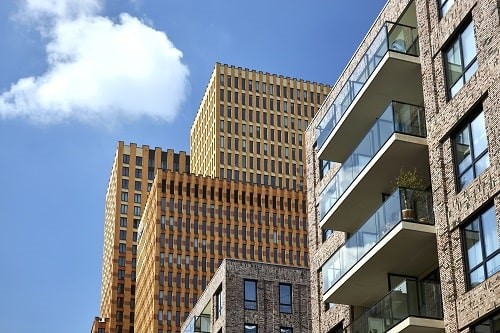Last month, the industry marked five years since the Grenfell Tower tragedy, remembering the 72 people who lost their lives, those who were injured, and their families and friends, and reflecting on the impact the disaster has had on the local community and residents in high-rise buildings across the country.
Opinion
Managing fire safety in high-risk residential buildings: the challenges ahead
With the Building Safety Bill receiving Royal Assent, the coming months will be a significant period of preparation and transition for all professionals in the built environment industry, as the new regime comes into effect, marking a new chapter for building safety. The Building Safety Act has introduced clear accountabilities for all those involved in the construction, upkeep and repair of high-risk buildings in England.
Whilst we await the specific details on statutory regulations of how the new Act will work in practice, the revolutionary new regime and regulatory framework should ensure that a tragedy like Grenfell never happens again.
 Andrew Bulmer: "We are concerned about the potential ‘wiggle room’ that the developer pledge exposes."
Andrew Bulmer: "We are concerned about the potential ‘wiggle room’ that the developer pledge exposes."
As an industry, we must work collaboratively with government and other stakeholders to ensure the new Act can become the robust safety net which the industry has been striving for and ensure that the regulations and implementation of the Act are proportionate and practical. We must transform the industry culture, remove the loopholes, commit to robust regulation and fair governance, expand and develop resources, and eradicate complacency.
As the leading professional body representing the leasehold and build-to-rent property management sectors, The Property Institute (TPI) has been leading the charge for the new building safety regime, while seeking to protect residents from the significant costs of remediation.
We are pleased that policymakers have listened to key suggestions from TPI and other industry bodies to improve how the new regime will work in practice, but there remain some key challenges and concerns about the road ahead.
A question of standards
Most recently, our industry is concerned about the ambiguity of remediation standards and proportionality, particularly in light of the new Developer Pledge.
Under pressure from secretary of state, Rt. Hon. Michael Gove, a number of housebuilders and developers have committed to funding remediation for past defects and poor work on their buildings (45 have signed up to the Developer Pledge, as of June 2022).
 We must act now to ensure that remediation of buildings by developers, and any new developments already in planning, consistently adhere to the correct standards. Photograph: iStock
We must act now to ensure that remediation of buildings by developers, and any new developments already in planning, consistently adhere to the correct standards. Photograph: iStock
This is a very positive development, however, as pointed out by Dame Judith Hackitt and the Industry Safety Steering Group (ISSG), only around half of them have signed up to the Building a Safer Future Charter (established to promote culture change and to help improve building safety for all those working in the built environment). Also, only four are pursuing Charter Champion status.
In addition, the ISSG has reported that a number of new high-rise development planning proposals have been referred back by the Building Safety Regulator at the first hurdle due to poor fire safety design issues, a troubling situation as one would have hoped the construction sector is fully committed to building better and safer going forward, as well as fixing the mistakes of the past.
Secondly, we are concerned about the potential ‘wiggle room’ that the developer pledge exposes. Developers returning to fix their residential blocks are challenging earlier remediation specifications, while the basis of assessment has already changed, with the introduction of the PAS 9980 standard for external wall systems in January this year, and the role of the Building Safety Regulator (BSR).
PAS 9980 effectively replaces the now withdrawn Consolidated Advice Note and it is intended to take a more holistic approach to remediation of external wall systems.
For example, some cladding might be safe on a building if other measures, perhaps installing sprinklers, were taken. The point is that the two standards are different, and some developers are rejecting solutions under the former regime and switching to lest costly solutions under the latter. In theory, that should be fine, but who is marking their homework to ensure the end result is safe? Going further, will the Building Regulator agree it is safe, as per the Building Safety Act, which has a wider definition of fire and structural safety? We don’t want to be fixing buildings twice to meet the standards required by the future Regulator.
We must act now to ensure that remediation of buildings by developers, and any new developments already in planning, consistently adhere to the correct standards, encompassing both the structural and fire safety requirements of the Building Safety Act, and PAS 9980.
Under the new Act, landlords, building owners (in some cases, resident directors), and in certain circumstances their appointed managing agents, will become Accountable Persons (APs) – statutory duty-holders – and they need to have access to expertise and competent professionals who will carry out risk assessments to a suitable and consistent standard.
Within our sector, this means consistency of standards by a robust supply of competent and qualified assessors to carry out safety inspections on remediation work, and that of any new buildings under development.
We expect that the BSR, and the wider building safety industry, will lead in the development of standards for competency and prescribe how these will be effectively implemented within key building safety roles, as well as the design of frameworks that set out minimum standards of competence for individuals and organisations managing building safety.
We would of course welcome the opportunity to be involved in the development and delivery of these standards across the sector, to represent the interests and concerns of our thousands of property management professionals, collectively responsible for tens of thousands of blocks and their residents, up and down the country.
Volunteer lay directors of Resident Management Companies (RMCs) are very unlikely to have the competence, knowledge and skills to meet their AP/Principal AP obligations under the Act. TPI successfully submitted an amendment to the Act, enabling those directors to engage a professional Building Safety Director to take on their onerous responsibilities.
Meanwhile, the proposed Building Safety Manager (BSM) role was dropped from the Bill and did not make the final Act. However, the functions of the BSM still need to be carried out. Someone still needs to do the work to keep the building safe. In large part, that will fall to the day-to-day building managers, who carry out many of the functions already.
However, there will be some extra work and managers need to be very clear what they do and don’t do, and always stay within their sphere of competency. This especially applies to any functions the Principal AP/AP might try to pass down to them, for example, maintaining the Building Safety File and system, and having the building certified by the Regulator. This work is new and brings additional risk.
What’s next?
The Building Safety Act, along with the Fire Safety Act, has given us greater clarity and some assurances that Grenfell and other such tragedies will be prevented. The tools and the frameworks to help industry make the changes for the future are almost in place, and ready to be taken up by the entire supply chain and professions.
The first requirements of the Building Safety Act – building registration and the building control competency frameworks – are expected to be launched in April 2023, with the responsibilities and duties on Accountable Persons to be introduced in October 2023.
The BSR Safety Cases approach (to show that all reasonable steps have been taken to make sure ‘in scope’ buildings – those at least 18m in height, or have seven storeys and at least two residential units – are safe and will remain safe when occupied by residents) is likely to follow six months after that, in April 2024, and we welcome the Health and Safety Executive’s recent publication of an online ‘toolkit’, designed to assist with preparing safety cases, with information and advice on what the BSR is likely to need in any submission.
Already, there has been some evidence of good practice across private and social housing sectors since Grenfell, with agencies, industry bodies, and other suppliers and organisations getting to grips with cladding and fire safety risks and building remediation. As more detail of the new regime emerges over the next 12 to 18 months, the industry must start gearing up, and we don’t have a lot of time.
We need to keep the momentum and ensure that key professionals are suitably prepared and equipped with the understanding, competency, and qualifications to ensure residential buildings are built and managed in-line with the new regulatory framework, as soon as possible.
Andrew Bulmer is CEO of The Property Institute.
For more information see: tpi.org.uk
OPINION

Why your business should act on engine idling
By Jack Alexander, project officer, Idling Action London on 01 October 2021

The air we breathe is all our business
By Nicky O’Malley, director of corporate partnerships, Global Action Plan on 01 June 2023
Businesses have a vital role to play in improving air quality – and the UK’s Clean Air Day on 15 June is a great opportunity for companies to begin or renew their efforts in this area.

All jobs greener: why we need workforce transformation for a sustainable future
By Martin Baxter, deputy CEO, IEMA (Institute of Environmental Management & Assessment) on 01 June 2022
The shift to a green economy will create green jobs within new and emerging sectors, while those working in existing sectors will have to gain the requisite green skills to take advantage of the business value-creation opportunities that come from embedding sustainability across the whole organisation.



